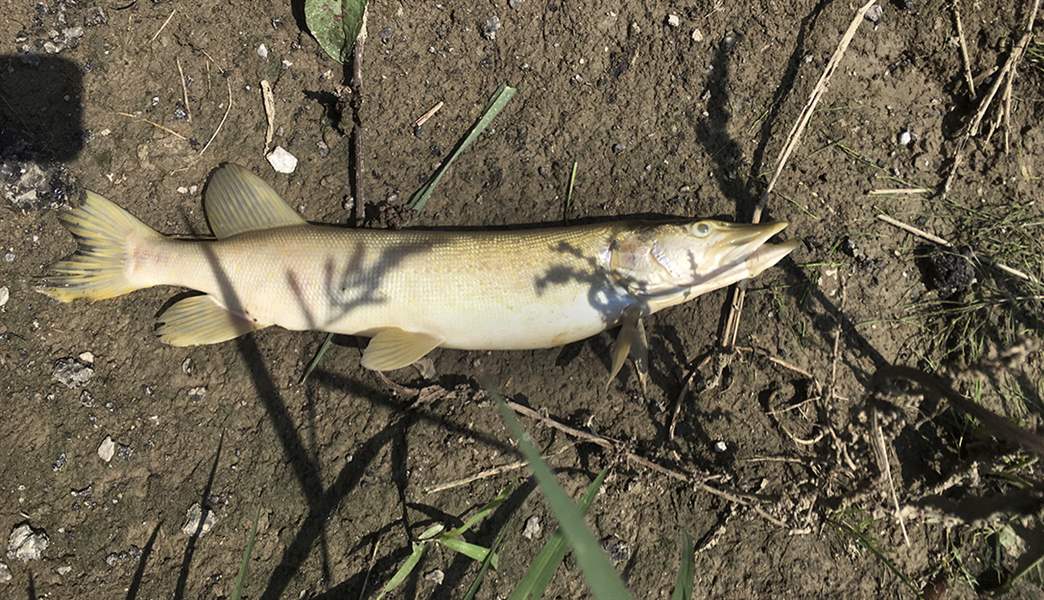
State department finishes dead fish investigation
10/10/2017
A dead northern pike found along a creek in Williams county in August.
OHIO DEPARTMENT OF NATURAL RESOURCES
The Ohio Department of Natural Resources said Tuesday it has completed its investigation into three separate cases of illegal manure-spreading that resulted in 66,701 fish and possibly other animals being killed in the Maumee River watershed in August.
The department is seeking a total of $32,782.87 in restitution, Matt Eiselstein, Ohio DNR spokesman, said.
The Ohio DNR’s investigation is apparently one of three underway. Earlier, the Ohio Department of Agriculture and the Ohio Environmental Protection Agency said they were doing parallel investigations to determine if rules pertaining to their agencies were violated as well.
RELATED: Groups urge faster action to reduce algae in Lake Erie
Those identified by the Ohio DNR along with the amount of restitution being sought are:
■ Dan Wagner, of DJ Wagner Acres LLC, 10759 County Road 175, Kenton, Ohio, who was told in writing the Ohio DNR believes 14,615 fish or other wild animals were killed as a result of a manure release to a portion of Bloom Ditch and the Blanchard River in Hardin County’s Pleasant and Blanchard Townships on or about Aug. 4. Restitution in the amount of $6,142.03 is being sought.
■ David Youngpeter, of 633 S. Acadia Rd., Spencerville, Ohio, who was told in writing the Ohio DNR believes 36,822 fish or other wild animals were killed as a result of a manure release to a portion of Jennings Creek in Allen County’s Jennings Township on or about Aug. 5 and Aug. 6. Restitution in the amount of $14,550.37 is being sought.
■ Mike Bockey of Bockey’s Ag-Lime, 9339 Brickner Rd., Delphos, Ohio, who was told in writing the Ohio DNR believes 15,264 fish or other wild animals were killed as a result of a manure release to a portion of Beaver Creek in Williams County’s Jefferson Township on or about Aug. 17. Restitution in the amount of $12,090.47 is being sought.
Efforts to reach each were unsuccessful on Tuesday. Messages were left for Mr. Wagner and Mr. Bockey. The Youngpeter residence has an unlisted phone number.
Each were notified by letters sent via certified mail and signed by Michael R. Miller, Ohio DNR Division of Wildlife chief. In the letters, Mr. Miller stated he “must insist that the state be compensated for its loss” and asked for checks to be sent to the division’s headquarters in Columbus by Nov. 6 for Mr. Bockey and Nov. 9 for Mr. Wagner and Mr. Youngpeter.
“Please be advised this figure does not represent the full amount that will be sought should the Division be required to file suit, but represents a compromise put forward for purposes of settlement only,” the letters state.
Several people tracking the ongoing fouling of western Lake Erie from algae-growing phosphorus, which is in animal manure, have cited the cases as potential game-changers as the state examines how strong and effective its rules are for agriculture.
Toledo Mayor Paula Hicks-Hudson, in recent letters to Ohio Gov. John Kasich and President Trump, cited fish kills — especially the most recent case in Williams County — as one reason why she is now supporting calls for designating western Lake Erie as impaired. The mayor resisted such calls for two years, but said the fish kills and the recent algal bloom along the Maumee River near downtown changed her mind.
Such an impairment designation would subject agricultural operators to tighter rules designed to reduce nutrient releases.
In each case, manure was believed to have been applied improperly or just before rain arrived, killing fish with oxygen-robbing ammonia that got into the water.
A fourth release in the Maumee River watershed that month, in a portion of Little Black Creek that flows through Mercer County near Rockford, Ohio, was likewise believed to have been the result of an illegal manure release. But no carcasses were found.
Environmentalists have implored the Kasich administration to do more for Lake Erie and its tributaries since 500,000 metro Toledo residents were told to temporarily avoid their tap water in 2014 because of an algal toxin that had breached the city’s water-treatment system. Manure and other farm-based nutrients were blamed for making a bloom in the lake too toxic for the city.
Brett Gates, Ohio Department of Agriculture deputy communications director, said in August the state agriculture department works “to ensure operations are following laws” that are intended to protect the environment while allowing the industry to be productive.”
Contact Tom Henry at thenry@theblade.com, 419-724-6079, or via Twitter @ecowriterohio.